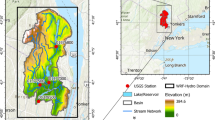Abstract
A systematic approach is needed to use water more productively, because water shortages limit socio-economic development in many parts of the world. The aim of this paper is to establish a surrogate-based simulation–optimization approach to identify parameter values for a fully integrated surface water and groundwater flow coupling simulation. A surface water and groundwater flow coupling simulation model was implemented using HydroGeoSphere (HGS) model and the parameter sensitivities in the model were analyzed using local sensitivity analysis method. The parameters that exerted a large influence on the output results of the HGS model were then selected as stochastic variables, and the stochastic variable data sets were generated using the latin hypercube sampling (LHS) method, which, thereby, were used as inputs in HGS model to obtain the corresponding outputs. On the basis of input and output data sets, a kriging surrogate model of the HGS model was then established and verified, and parameter values of HGS model were identified using a surrogate-based simulation–optimization approach. The results of this study show that parameters that exert a large influence on the simulation output results include hydraulic conductivity, porosity, the van genuchten parameter (\(\alpha\)), and channel manning coefficient. The established kriging surrogate model is an ideal alternative to the HGS model for simulating and predicting, while optimal parameter values can be identified effectively and accurately using the established approach. The results of this research reveal that huge computational loads can be mitigated while using the kriging surrogate as an alternative for a simulation model in the solution process of optimization model.





Similar content being viewed by others
References
An Y, Lu W, Cheng W (2015) Surrogate model application to the identification of optimal groundwater exploitation scheme based on regression kriging method—a case study of Western Jilin Province. Int J Environ Res Public Health 12(8):8897–8918
Brunner P, Simmons CT (2012) HydroGeoSphere: a fully integrated, physically based hydrological model. Groundwater 50(2):170–176
Castillo E, Hadi AS, Conejo A, Fernández-Canteli A (2004) A general method for local sensitivity analysis with application to regression models and other optimization problems. Technometrics 46(4):430–444
Cornelissen T, Diekkrüger B, Bogena H (2013) Using HydroGeoSphere in a forested catchment: how does spatial resolution influence the simulation of spatio-temporal soil moisture variability? Procedia Environ Sci 19:198–207
Gottardi G, Venutelli M (1993) A control-volume finite-element model for two-dimensional overland flow. Adv Water Resour 16(5):277–284
Graham DN, Refsgaard A (2001) MIKE SHE: a distributed, physically based modeling system for surface water/groundwater interactions. In: MODFLOW 2001 and other modeling odysseys—Conference proceedings, pp 321–327
Gustafson P, Srinivasan C, Wasserman L (1996) Local sensitivity analysis. Bayesian Stat 5:197–210
Huang Y, Zhou Z, Yu Z (2009) The application of hydrogeosphere in simulating flow and solute transport of dam site in Jinping Hydropower Station. Chin J Hydrodyn 24(2):242–249
Kersaudy P, Sudret B, Varsier N, Picon O, Wiart J (2015) A new surrogate modeling technique combining Kriging and polynomial chaos expansions—application to uncertainty analysis in computational dosimetry. J Comput Phys 286:103–117
Kollet SJ, Maxwell RM (2006) Integrated surface–groundwater flow modeling: a free-surface overland flow boundary condition in a parallel groundwater flow model. Adv Water Resour 29(7):945–958
Kwon H, Yi S, Choi S (2014) Numerical investigation for erratic behavior of Kriging surrogate model. J Mech Sci Technol 28(9):3697–3707
Langevin C, Swain E, Wolfert M (2005) Simulation of integrated surface-water/ground-water flow and salinity for a coastal wetland and adjacent estuary. J Hydrol 314(1–4):212–234
Lu WX, Liu P, Xu W, Xin X (2011) Numerical simulation of groundwater and sensitivity analysis of parameters based on hydrogeosphere technology. Water Resour Power 6:022
Panday S, Huyakorn PS (2004) A fully coupled physically-based spatially-distributed model for evaluating surface/subsurface flow. Adv Water Resour 27(4):361–382
Panday S, Huyakorn PS, Therrien R, Nichols RL (1993) Improved three-dimensional finite-element techniques for field simulation of variably saturated flow and transport. J Contam Hydrol 12(1–2):3–33
Rakovec O, Hill MC, Clark MP, Weerts AH, Teuling AJ, Uijlenhoet R (2014) Distributed evaluation of local sensitivity analysis (DELSA), with application to hydrologic models. Water Resour Res 50(1):409–426
Singh RM, Datta B (2006) Identification of groundwater pollution sources using GA-based linked simulation optimization model. J Hydrol Eng 11(2):101–109
Sudicky E, Park Y, Unger A, Jones J, Brookfield A et al (2006) Simulating complex flow and contaminant transport dynamics in an integrated surface-subsurface modelling framework. In: GSA annual meeting and exposition, Philadephia, vol 38. Geological Society of America Abstracts with Programs, Boulder, CO, p 258
Tapoglou E, Karatzas GP, Trichakis IC, Varouchakis EA (2014) A spatio-temporal hybrid neural network-Kriging model for groundwater level simulation. J Hydrol 519:3193–3203
Therrien R, McLaren RG, Sudicky EA, Panday SM (2010) HydroGeoSphere: a three-dimensional numerical model describing fully-integrated subsurface and surface flow and solute transport. Groundwater Simulations Group, University of Waterloo, Waterloo
Therrien R, Sudicky EA, Park YJ, McLaren RG (2012) HydroGeoSphere: a three-dimensional numerical modelling describing fully-integrated subsurface and surface flow and transport. Aquanty Inc, Waterloo
VanderKwaak JE (1999) Numerical simulation of flow and chemical transport in integrated surface-subsurface hydrologic systems. Dissertation, University of Waterloo
VanderKwaak JE, Loague K (2001) Hydrologic-response simulations for the R-5 catchment with a comprehensive physics-based model. Water Resour Res 37(4):999–1013
Zhao Y, Lu W, Xiao C (2016) A Kriging surrogate model coupled in simulation–optimization approach for identifying release history of groundwater sources. J Contam Hydrol 185:51–60
Acknowledgements
This research was funded by the China Geological Survey (no. DD20160266), China National Natural Science Foundation (41372237), and Project 2017149 supported by Graduate Innovation Fund of Jilin University.
Author information
Authors and Affiliations
Corresponding author
Rights and permissions
About this article
Cite this article
An, Y., Lu, W. & Yan, X. A surrogate-based simulation–optimization approach application to parameters’ identification for the HydroGeoSphere model. Environ Earth Sci 77, 621 (2018). https://doi.org/10.1007/s12665-018-7806-7
Received:
Accepted:
Published:
DOI: https://doi.org/10.1007/s12665-018-7806-7




